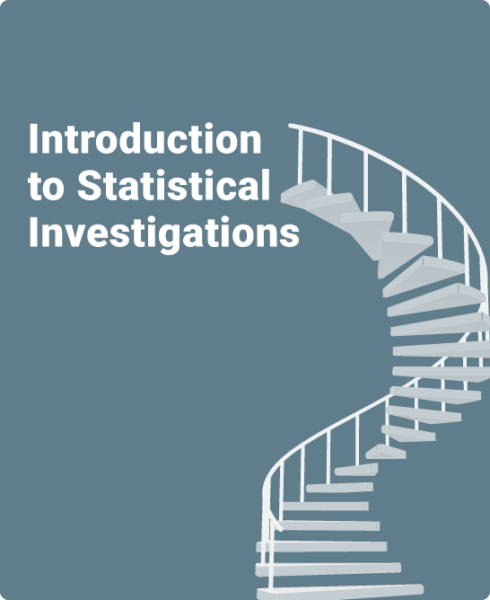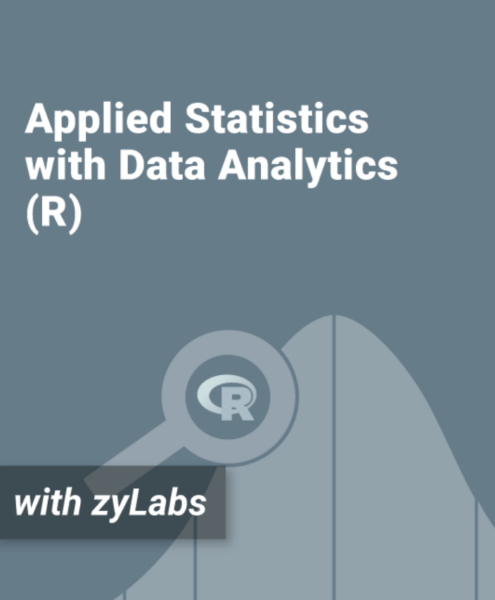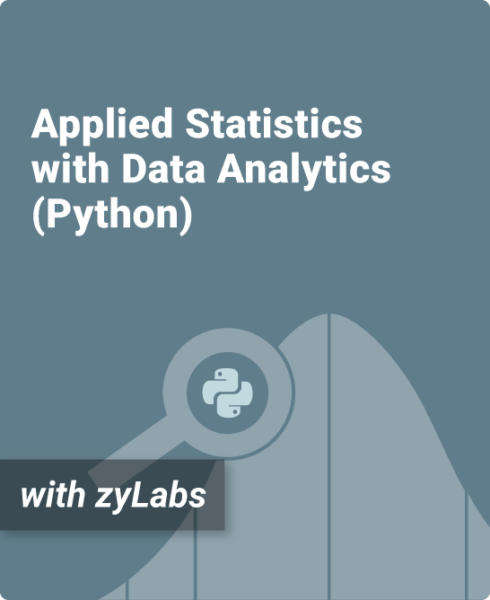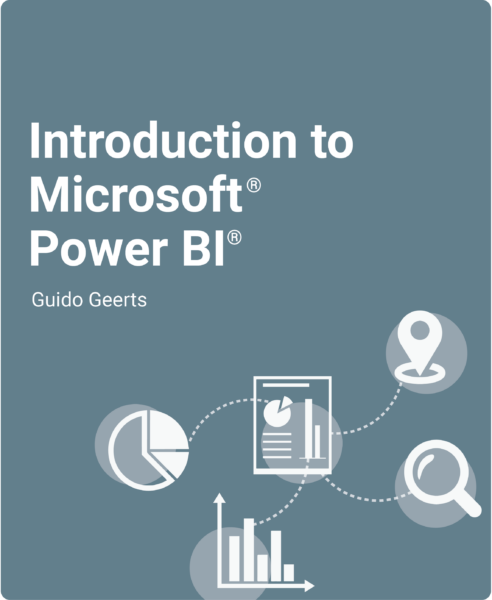Table of Contents
1. Introduction to Statistical Investigations
1.1 Preliminary: Introduction to the six-step method
1.2 Preliminary: Exploring data
1.3 Preliminary: Exploring random processes
1.4 Data and formulas
2. Significance
2.1 Example: Introduction to chance models
2.2 Example: Measuring the strength of evidence
2.3 Example: Alternative measure of strength of evidence
2.4 Example: What impacts strength of evidence?
2.5 Example: Inference on a single proportion: Theory-based approach
2.6 Supplemental Exploration: Introduction to chance models
2.7 Supplemental Exploration: Measuring the strength of evidence
2.8 Supplemental Exploration: Do People Use Facial Prototyping?
2.9 Supplemental Exploration: Competitive Advantage to Uniform Colors?
2.10 Supplemental Exploration: Eye Dominance
2.11 Investigation: Tire story falls flat
2.12 Tools, data, and formulas
3. Generalization
3.1 Example: Sampling from a finite population
3.2 Example: Inference for a single quantitative variable
3.3 Example: Theory-based Inference for a Population Mean
3.4 Example: Other Statistics
3.5 Supplemental Exploration: Sampling Words
3.6 Supplemental Exploration: Inference for a single quantitative variable
3.7 Supplemental Exploration: Sleepless Nights?
3.8 Supplemental Exploration: Other statistics
3.9 Investigation: Faking cell phone calls
3.10 Tools, data, and formulas
4. Estimation
4.1 Example: Statistical inference: Confidence intervals
4.2 Example: 2SD and theory-based confidence intervals for a single proportion
4.3 Example: 2SD and theory-based confidence intervals for a single mean
4.4 Example: Factors that affect the width of a confidence interval
4.5 Supplemental Exploration: Statistical inference: Confidence intervals
4.6 Supplemental Exploration: 2SD and theory-based confidence intervals for a single proportion
4.7 Supplemental Exploration: 2SD and theory-based confidence intervals for a single mean
4.8 Supplemental Exploration A: Factors that affect the width of a confidence interval
4.9 Supplemental Exploration B: Factors that affect the width of a confidence interval
4.10 Investigation: Cell phones while driving
4.11 Tools, data, and formulas
5. Causation
5.1 Example: Association and confounding
5.2 Example: Observational studies vs. experiments
5.3 Supplemental Exploration: Association and confounding
5.4 Supplemental Exploration: Observational studies versus experiments
5.5 Investigation: High anxiety and sexual attraction
5.6 Tools and data
6. Comparing Two Proportions
6.1 Example: Comparing two groups: Categorical response
6.2 Example: Comparing two proportions: Simulation-based approach
6.3 Example: Comparing two proportions: Theory-based approach
6.4 Supplemental Exploration: Comparing two groups: Categorical response
6.5 Supplemental Exploration: Comparing two proportions: Simulation-based approach
6.6 Supplemental Exploration: Comparing two proportions: Theory-based approach
6.7 Investigation: Does vitamin C improve your health?
6.8 Tools, data, and formulas
7. Comparing Two Means
7.1 Example: Comparing two groups: Quantitative response
7.2 Example: Comparing two means: Simulation-based approach
7.3 Example: Comparing two means: Theory-based approach
7.4 Supplemental Exploration: Comparing two groups: Quantitative response
7.5 Supplemental Exploration: Comparing two means: Simulation-based approach
7.6 Supplemental Exploration: Comparing two means: Theory-based approach
7.7 Investigation: Memorizing letters
7.8 Tools, data, and formulas
8. Paired Data
8.1 Example: Paired designs
8.2 Example: Simulation-based approach for analyzing paired data
8.3 Example: Theory-based approach to analyzing data from paired samples
8.4 Supplemental Exploration: Paired designs
8.5 Supplemental Exploration: Simulation-based approach for analyzing paired data
8.6 Supplemental Exploration: Theory-based approach for analyzing paired data
8.7 Investigation: Filtering water in Cameroon
8.8 Tools, data, and formulas
9. Comparing More Than Two Proportions
9.1 Example: Comparing multiple proportions: Simulation-based approach
9.2 Example: Comparing multiple proportions: Theory-based approach
9.3 Example: Chi-square goodness-of-fit test
9.4 Supplemental Exploration: Comparing multiple proportions: Simulation-based approach
9.5 Supplemental Exploration A: Comparing multiple proportions: Theory-based approach
9.6 Supplemental Exploration B: Comparing multiple proportions: Theory-based approach
9.7 Supplemental Exploration: Chi-square goodness-of-fit test
9.8 Investigation: Who yields to pedestrians?
9.9 Tools, data, and formulas
10. Comparing More Than Two Means
10.1 Example: Comparing multiple means: Simulation-based approach
10.2 Example: Comparing multiple means: Theory-based approach
10.3 Supplemental Exploration: Comparing multiple means: Simulation-based approach
10.4 Supplemental Exploration: Comparing multiple means: Theory-based approach
10.5 Investigation: Aggression
10.6 Tools, data, and formulas
11. Two Quantitative Variables
11.1 Example: Two quantitative variables: Scatterplot and correlation
11.2 Example: Inference for correlation coefficient: A simulation-based approach
11.3 Example: Least squares regression
11.4 Example: Inference for regression slope: Simulation-based approach
11.5 Example: Inference for regression slope: Theory-based approach
11.6 Supplemental Exploration: Two quantitative variables: Scatterplot and correlation
11.7 Supplemental Exploration: Inference for correlation coefficient: A simulation-based approach
11.8 Supplemental Exploration: Least squares regression
11.9 Supplemental Exploration: Inference for regression slope: Simulation-based approach
11.10 Supplemental Exploration: Inference for regression slope: Theory-based approach
11.11 Investigation: Association between hand span and candy?
11.12 Tools, data, and formulas
12. Modeling Randomness
12.1 Example: Basics of probability
12.2 Example: Probability rules
12.3 Example: Conditional probability and independence
12.4 Example: Discrete random variables
12.5 Example: Random variable rules
12.6 Example: Binomial and geometric random variables
12.7 Example: Continuous random variables and normal distribution
12.8 Example: Revisiting theory-based approximations of sampling distributions
12.9 Supplemental Exploration: Basics of probability
12.10 Supplemental Exploration: Probability rules
12.11 Supplemental Exploration A: Conditional probability and independence
12.12 Supplemental Exploration B: Conditional probability and independence
12.13 Supplemental Exploration: Discrete random variables
12.14 Supplemental Exploration: Random variable rules
12.15 Supplemental Exploration: Binomial and geometric random variables
12.16 Supplemental Exploration A: Continuous random variables and normal distribution
12.17 Supplemental Exploration B: Continuous random variables and normal distribution
12.18 Supplemental Exploration A: Revisiting theory-based approximations of sampling distributions
12.19 Supplemental Exploration B: Revisiting theory-based approximations of sampling distributions
13. Instructor Resources
13.1 Under the Spiral: How the ISI zyBook teaches the Statistical Investigation Process
13.2 Examples and Explorations
What You’ll Find In This zyBook:
More action with less text.
- Bring text author’s SBI approach to learning statistics into a new course management platform
- Students interact with assignable reading made up of embedded in the text guided animations, simulation tools and learning questions with answer-specific feedback
- Build confidence and conceptual understanding of the statistical process
- Challenge Activities deliver higher stakes assessment
Scaffolding in the ISI zyBook:
What is a zyBook?
Introduction to Statistical Investigations is a web-native, interactive zyBook that helps students visualize concepts to learn faster and more effectively than with a traditional textbook. (Check out our research.)
Since 2012, over 1,200 universities and colleges across the country have adopted digital zyBooks to transform their STEM education.
zyBooks benefit both students and instructors:
- Instructor benefits
- Customize your course by reorganizing existing content, or adding your own content
- Continuous publication model updates your course with the latest content and technologies
- Robust reporting gives you insight into students’ progress, reading and participation
- Save time with auto-graded labs and challenge activities that seamlessly integrate with your LMS gradebook
- Build quizzes and exams with hundreds of included test questions
- Student benefits
- Learning questions and other content serve as an interactive form of reading
- Instant feedback on labs and homework
- Concepts come to life through extensive animations embedded into the interactive content
- Review learning content before exams with different questions and challenge activities
- Save chapters as PDFs to reference the material at any time
Authors
Nathan Tintle / Professor, Statistics / University of Illinois Chicago
Beth Chance / Professor, Statistics / California Polytechnic University
George Cobb / Robert L. Rooke Professor Emeritus, Statistics / Mount Holyoke College
Allan Rossman / Professor and Department Chair, Statistics / California Polytechnic University
Soma Roy / Professor, Statistics / California Polytechnic University
Todd Swanson / Associate Professor, Mathematics and Statistics / Hope College
Jill VanderStoep / Assistant Professor, Mathematics and Statistics / Hope College
zyBooks Authors
Julia Schedler / PhD in Statistics / Rice University
Ayla Sánchez / Senior Content Developer, Statistics / zyBooks / PhD in Mathematics / Tufts University



